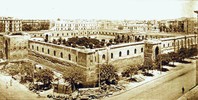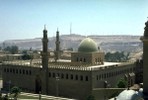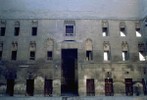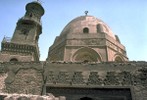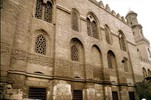Previous Lecture | Next Lecture
Concepts
The Ayyubids: A family of Kurdish amirs who ruled Syria and Egypt (1176-1250). Their founder was Salah al-Din (Saladin), the exemplary knight and hero of the Counter-Crusade.
The Mamluks: A curious phenomenon that is not encountered outside the Islamic world, Mamluks were imported slaves, mostly of Turkish or Caucasian stock, who were destined for a military career. The Mamluks ruled Egypt and Syria from 1250 to 1517.
Waqf: Endowment deed. In the medieval period, amirs and dignitaries endowed charitable structures both for pious and social reasons and as a means to preserve some of the wealth generated by their iqta', or revenues form land holdings granted by the state only while they are actively in the service.
Khanqah: Institution for sufis which usually contains a mosque, quarters for a number of sufis, and a meeting hall where the hudur is performed. Its introduction into the urban environmrnt in major cities marked the recognition of popular religious practices by both the ruling and the clerical classes.
Hudur: Sufi acts of devotion which took the form of dancing, singing, and whirling among other ways. Each Sufi order had its distinctive hudur.
Monuments
Madrasa of Sultan al-Salih Najm al-Din Ayyub
(1243) First madrasa in Cairo to accommodate the four schools of law. Built in the heart of the Fatimid city, it was composed of two separate, self-contained courtyard units, parallel in plan, separated by a passage, and having each two large iwans. A mausoleum for the founder was added shortly after the completion of the complex by Shajar al-Durr, his wife.
The Mosque of Sultan al-Zahir Baybars in Cairo
(1267-9): First royal Mamluk mosque in Cairo. Hypostyle in plan, and fortress-like in elevation, the mosque with its three portals displays local and Seljuk influences. Its minbar and mihrab are said to have been built with wood and marble taken from a Crusader's church in Jaffa.
The Mosque of Sultan al-Nasir Muhammad in Cairo
(1318 and 1335). This hypostyle structure is distinguished by the arrangement of alternate courses of red and black stone in its arches and niches, and by its two unusual minarets which may have been a direct import from Ilkhanid Iran.
The Khanqah of Sultan Baybars al-Jashankir
(1307-10). A structure with a biaxial plan, this Khanqa had a mausoleum added on its qibla side. It contained rooms for the sufis aligned on its two longitudinal sides.
The Complex of Sultan Qalawun in Cairo
(1284-85). Contains a bimaristan (hospital), a madrasa, and a mausoleum for the founder. The street façade is well articulated and shows the confluence of Syrian (Crusader and Islamic) arrangements. The madrasa is a four-iwan type with a basilical organization in the qibla iwan. The Dome of the mausoleum echoes the octagonal plan of the Dome of the Rock.


